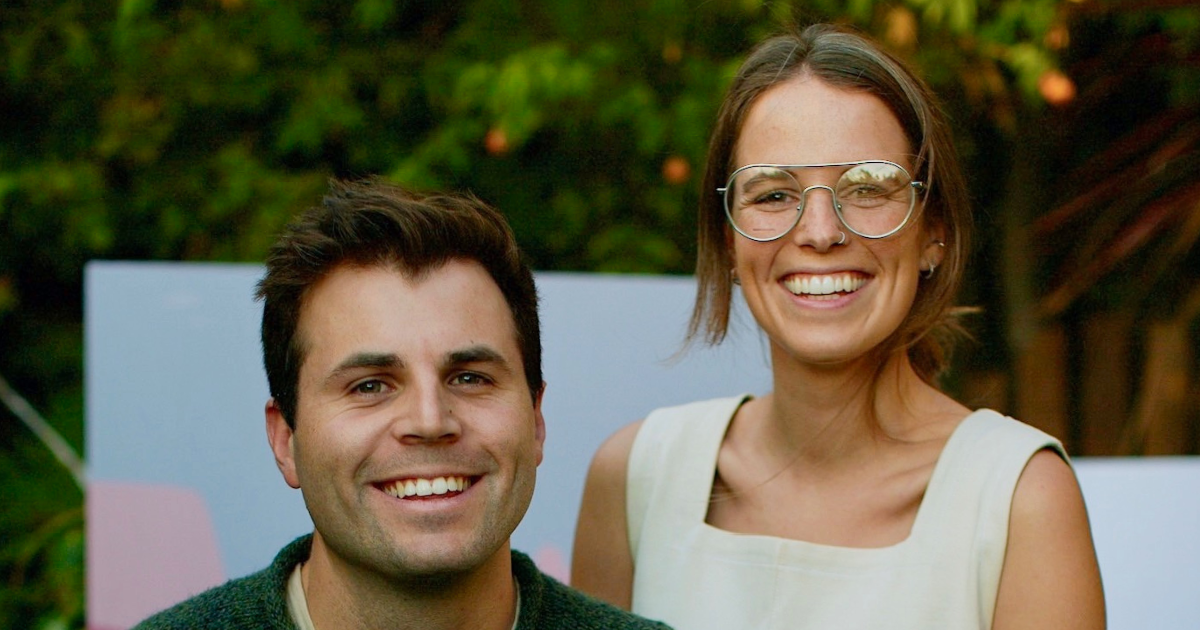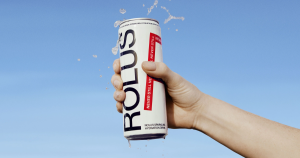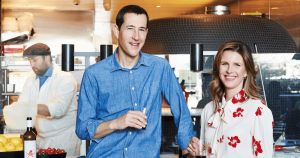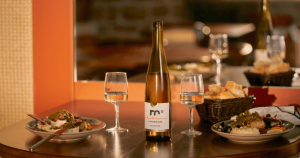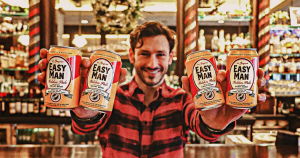From kitchen experiments to a burgeoning beverage brand, Maddie and Paul Voge’s journey with Aura Bora began with a simple observation: the sparkling waters Paul enjoyed at work couldn’t hold a candle to the concoctions they crafted at home.
In this interview, they dive into life as a husband-wife team, their rapid approach to product iteration, and the strategy behind Aura Bora’s Dry Guys non-alcoholic cocktail brand extension. They also explore the evolving landscape of alcohol consumption and their vision for Aura Bora’s role as an evening beverage. With a focus on creativity, quality, and a bit of wackiness, Maddie and Paul are challenging beverage incumbents, one unique flavor at a time.
You started in your kitchen, experimenting for yourself and friends. What was the impetus for that in the first place as two people with full-time jobs—and probably not a lot of time to think about beverage innovation?
Paul: Maddie and I don’t drink soda. We grew up in households that drank a lot of sparkling water. And I was working at this tech company with a fully-stocked pantry that I’m sure you’ve seen made fun of on the internet. The ones where you have Jeni’s ice cream and Justin’s peanut butter cups.
They had La Croix. First, it felt odd to me that I was drinking a gallon of La Croix every day—10 or 11 cans—and then I’d come home and make my own version with the SodaStream. I just thought, “man, it’s so odd that the version we make at home is so much better than what I’m drinking in the office.”
Second—and my office mates agreed with me—while La Croix was by far the most popular item consumed in terms of units moved out of the fridge, it was by far the least popular item in terms of taste, quality, and enjoyment.
It just felt like there was this odd disconnect for such a large category. Both Maddie and I, when we started making these concoctions at home, we both felt like, “hey, this is something we would drink. It’s something a lot of our friends would drink that doesn’t feel like it’s adequately reflected on the shelf.”
So, you saw a gap. But few people evolve that kitchen experimentation into a full fully-fledged beverage company. Plus, working together as a husband and wife team is fairly rare. Can you talk a bit about the decision to go into this as a business together?
Maddie: When we started out, we knew Paul was going to go into this full time. I feel like he definitely has something coded into his DNA that makes him want to run things, try his own things out. And Paul knew I wanted to start something. I didn’t want to have a boss anymore. I really wanted to try this entrepreneurship thing.
It just made sense for us. I kept my full-time job as a designer elsewhere for a couple of years while Paul was scaling Aura Bora—when we weren’t quite ready to put all of our eggs in this basket. It’s a big risk. It’s like, “okay, are we all going to go all in on this, or should we hedge our bets with some other kind of income stream?”
Finally, we were like, “okay, let’s do this.” Paul and I both have similar opinions on what it’s like working together. It’s been really great. Thankfully, we’re quite siloed in our positions. I’m really focused on creative. Paul really focuses on running the company, operations, broader strategy, fundraising.
We’ve always said: as hard as it is working together on this big mission, the only harder thing I can imagine is not doing it together. When we’re so stressed and preoccupied with how hard this is, there’d be no possible way we’d understand each other if we weren’t in it together.
Paul: I remember joking to Maddie—I drink a lot more sparkling water than Maddie, both then and today—“hey, worst case scenario, the first production run is 36,000 cans. I’m going to consume that in my lifetime. If this doesn’t work, we lose a lot of our money off our credit card, and I just bought a lifetime’s worth of sparkling water for myself. It’s a complicated way of grocery shopping.” But it didn’t feel as risky as it probably should have.
On the working together piece, I’ll echo what Maddie said. There were days when it felt so stressful, particularly in the first couple of years when Maddie was paying our rent. Obviously, we weren’t saving money because I wasn’t making any money working at Aura Bora. It felt super stressful and I thought, “how can I be this stressed about lavender water? This is not a big deal. Like, we’re not transporting hearts over the Bay Bridge for surgery. The stress level needs to come down.”
On the other hand, when you start hiring employees and there are lives wrapped up in this, we’re both providing for our team. We’re getting great messages from people ditching alcohol or ditching soda. It does become more than just a pallet of lavender water. It becomes a real brand with legs and arms of its own. So, the stress is both unnecessary at times and needed at others. I hope that the stress feels more like responsibility and less like a burden.
Shifting to Aura Bora itself: tell us about your process for coming up with new products. Most brands have a few SKUs and meticulously research the market before they dare to launch a new one. It almost seems like you can have a weird idea in a dream and then, four weeks later, it’s on your site. Can you talk about how you come up with your formulations?
Paul: That has literally happened—creating products that we dream about has literally happened.
There are two sides of the business. Obviously what we sell in retail is closer to, “okay, we know we need to have a version of each of the big citrus SKUs.” So, we need a grapefruit and a lime and a lemon. We want our own twist on it, though, because big sparkling water companies do that. Can we do ginger with a Meyer lemon, lime with cardamom, and grapefruit with elderflower? Make something that is distinctively different and kind of delightful and peculiar—and calorie-free of course.
On the opposite side of the house, for a direct-to-consumer product, it’s extremely heavy. It’s a gallon of water in a box. So, there’s less of a reason for us to really invest a lot of time, money, resources, and talent into making these fun products.
But, at the same time, the whole basis of the business is that we’re trying to release flavors that people haven’t seen elsewhere. We want constant variety. As someone who drinks a gallon of it a day, I get tired quickly of the flavor. We want ingredients that you haven’t seen elsewhere used in a brand that hopefully feels like it’s speaking to you in the way you like to be spoken to. Can we come out with a monthly flavor the way a wine club might? We’re constantly making a new flavor. Like, at Thanksgiving, let’s sell something green bean flavored and see what people say. It’s been fun.
Love it. Maddie, from the creative side, bringing those weird flavors to life has to be the most fun part of this business for you, right?
Maddie: You’re right. It’s really fun. My favorite part is early in the process, trying to come up with what creatures are going on the cans. How are we going to write a haiku about every flavor? How do we write romance copy about what they taste like, so that even when people get an email about it, they have a sense of what they’re going to opt into?
It’s mayhem. Like, releasing a flavor every month is a hilarious frequency. The minute we have all the assets ready to go and launch, we start the next one. I’m constantly creating new email campaigns. We have amazing designers and an amazing email marketer. We’re just constantly cranking. And every single launch day is fun, too. Because you float it and you get this initial response.
We’ve done it enough now that we get to compare how many orders come in, how fast they’re coming in, who’s excited on our social media. Okay, people really like the sound of peach. Okay, cherry is kind of divisive. How do we learn from that? It’s been fun.
I imagine that for your Olive Oil Martini, it was a huge response—or maybe just because it penetrated our world of alcohol alternatives. I’d love to hear more about how that idea came to be and the collab with Graza, which of course is another cult favorite brand in addition to Aura Bora.
Maddie: We’re still hearing about it. It was a fun, viral moment—and it’s had a long tail. For one, we’ve been really inspired by our audience in the past couple of years. How many people have come to us and said, “Aura Bora has helped me get sober. It’s helped me stay sober.” It’s the reason that they’ve gotten off whatever it may be, soda or alcohol, things that they didn’t want to be participating in anymore. And that’s great.
But we also thought, “oh man, can we make a more caloric, denser, mocktail-y flavor profile?” That was the impetus for Dry Guys, which is what we’ve been calling this experimental line. Then Paul and Graza had these fun little moments where they started ideating on this.
Paul: I’ll go back even before Graza launched, before meeting Andrew [Benin] and Allen [Dushi]. The very first demo event I ever did was the fall of 2019 at a store maybe two miles away in San Francisco. A mom—she had two or three kids with her—she said, “great, lavender—I’ve actually been drinking this drink at 5:30 or 6:00 as a mocktail.” As silly as this sounds, I’d never heard that word. I didn’t even know. I just thought, “wow, she just said cocktail in a weird way. I wonder what she’s mixing this with.” That was the very first month we were selling the products.
Because of the herbal ingredients, certain consumers felt like, “hey, sure, I can have that at 2:00 at work, like a sparkling water. But I can also have it at 6:00 in place of when I’d normally enjoy alcohol.” That got our wheels turning. We vastly underestimated what a percentage of the audience that would be. I was a sparkling water drinker, so I just felt like everyone’s going to be drinking these the way that I drink sparkling water. That’s probably still the majority of our audience, but it’s not 80%, it’s like 51%. There are folks that are drinking this as an alternative to soda, folks that are drinking this as a mixer with alcohol, and then there’s this huge group that’s drinking this in place of alcohol.
Then as Graza launched, I got to know Andrew just before their public debut. In 2020, he said, “hey, why don’t we make an olive oil martini?” Six months later, we talked about it again, and then the following year we talked about it a third time. We said, “you know what, let’s just do this thing.” Our online audience made for a very fun, low stakes way of selling it. Now it’s in a few hundred stores, mostly in New York, which has also been fun. It’s a different price point. It’s a different audience. There’s a sub brand in Dry Guys underneath it, and we’ll certainly be coming out with a couple of other Dry Guy iterations for this specific audience of: at 6:00, what do you drink in place of alcohol?
You’re one of the few daytime beverages to successfully enter the alcohol alternatives space—the different use cases and higher price points. With Dry Guys, can you talk about what other flavors are in the pipe?
Paul: I’ll hint at a couple. What’s been most fun for Maddie and me to talk about: many members of our family are very much in the sober community. And there’s this odd line of sober-friendly and other alcohol-free products. I want everyone to consume them, whether you’re 30 years sober or for two days a week you choose not to drink alcohol. I’d like to sell to everyone on that spectrum.
The truth is, to sell to the former group, it can’t seem like alcohol. That’s why we like an olive oil martini. We don’t want this to be the last drink someone has before they go back to drinking when they didn’t want to be drinking. At the same time, it has to be full-bodied enough to make sense at 6:00 or on a menu next to alcoholic items.
Each of our iterations, regardless of flavor, will hopefully hit both of those. And it’s a very fine line to walk. Full bodied enough that everyone will feel like, “hey, that justifies its price point,” but not so close to alcohol that our sober family and friends couldn’t consume it. That’s the tightrope we’re walking. I can say one of them is quite fruity, like something you might have at, say, a tropical resort. The other is more like something you’d consume in a library in Scotland.
So, you’re addressing a range of palates. Maddie, from a creative and positioning perspective, as you think about extending the Dry Guys line, what challenges or opportunities do you anticipate there?
Maddie: For one, naming was a fun thing because we’re creating this little sub-brand. I want to make sure that people know our primary line is sparkling water. And there’s a lot of gray area in this non-alc space. Like, what are we calling these? How are we branding them? What differentiates a sparkling water from a sparkling aperitif? We don’t have the terminology down at all. So we’re definitely trying to be strongly, strongly communicative.
A big choice we made was not calling this a mocktail, but calling it a non-alcoholic cocktail. It felt like taking it more seriously. There’s something about the name mocktail that—it’s easy. A lot of people are familiar with it. But it was rubbing us not quite right. “Non-alcoholic cocktail” felt like: this isn’t a cute little fad. This is a category of its own and we’re working in it.
The other thing is making sure that, visually, this feels on-brand and super familiar. You could look at it and know it’s Aura Bora. But you’re not going to pick it up and then realize it doesn’t fit the same flavor profile. I’m working on it, but hopefully it will feel distinct but also familiar.
Now, get the crystal ball out: how are people’s beverage preferences going to change? As you’re thinking about your five or even 10-year plan for Aura Bora, where do you want to be?
Maddie: I feel like we’re watching this insane tidal wave of non-alcoholic drinkers. We have so many friends who have just decided: alcohol is just not for me. It doesn’t make me feel good and I don’t want to drink it anymore—or I’m not drinking it very often anymore and it’s nice to have other options.
That’s going to change a lot in the beverage space. How people consume and how people spend their money. I’m curious how many of these brands that are flooding grocery stores are going to end up being served at bars, being available on those menus. That’s a big change coming.
And, like many things right now, there’s so much saturation and so much competition because there’s so much information online to learn how to get into a different industry. There are going to be so many movers and shakers trying new things and new flavors. It’ll be fun.
Paul: I’ve loved the way things have gotten fuzzy in retail. Consumers who used to be only at Whole Foods now also shop at Walmart. Consumers who used to buy tea, now they buy sparkling tea. Next, they’re buying a functional—or let’s just call it expensive—beverage. It’s gotten more and more interesting, but frankly more and more crowded, and kind of complicated.
Consumers don’t want to need a PhD for when they go to the grocery store. So, we purposefully want sparkling water to be our Trojan horse walking into their fridge. Sparkling water is as boring a phrase as I could say. It’s dominated by private label, companies that sell more than a couple hundred million dollars per year, not interesting products that anyone’s writing home about.
I hope in ten years when people ask, “hey, what sparkling water do you drink?” I hope the one that they’re most enamored with, the creative one that they’re really excited about, the craft one that they pull out at a party, is Aura Bora.
We don’t need to dominate. We’ll never sell more than La Croix, period. On the non-alcoholic side, I would love it if everyone knew that, “hey, all Aura Bora products are delightful in similar ways, but at different price points and different use occasions.” If we could pull some of the delight we’ve created in sparkling water to non-alcoholic cocktails, that would be awesome. It’s the beginning of what will be a very large category, and we’re thrilled to be one of the brands making products for it.
Dry Atlas is a media company focused on alcohol alternatives. We deliver non-alc insights, news, and recs to over five million people annually. To stay up to date on all things non-alc, subscribe to our weekly newsletter.


